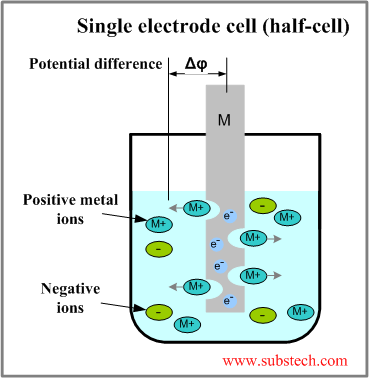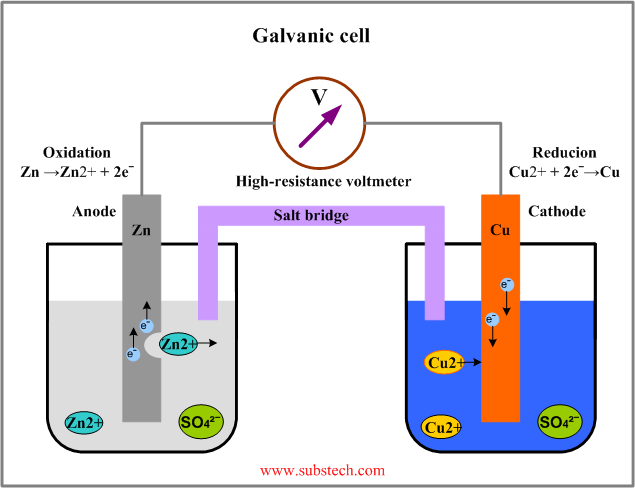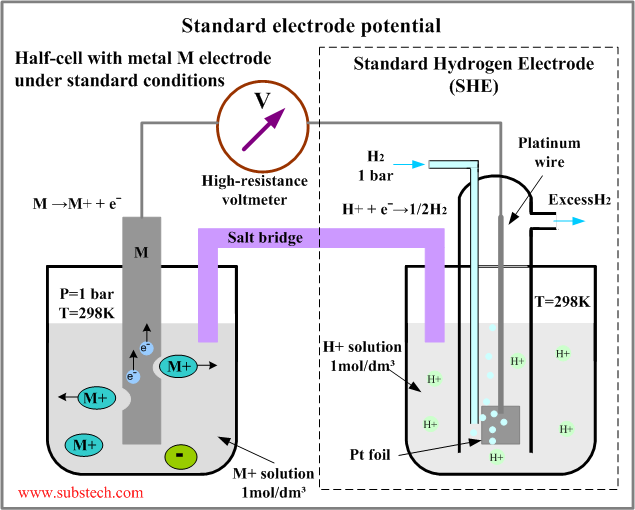Main page
About us
Sliding Bearings Consulting
Advertising Opportunities

to Metals
to Corrosion and oxidation
Electrode potentials
Dr. Dmitri Kopeliovich
Electrode potential is a fundamental conception of electrochemistry and corrosion theory. It helps to predict the direction and intensity of an electrochemical process (eg. corrosion) and allows to control it.
Oxidation and reduction
There are two meanings of the term oxidation.
The common (narrow) meaning of oxidation - chemical reaction (combining) between Oxygen and any other element resulting in formation of oxide.
For example calcium and oxygen combine forming calcium oxide:
Ca + 1/2O2 = CaO
In chemistry the term oxidation has a wider meaning:
Oxidation - is a chemical process, in which an element loses one or more of its electrons giving it/them up to another element.
The element receiving the electrons is not necessarily oxygen.
For example the reaction between calcium and chlorine is considered oxidation:
Ca + Cl2 = CaCl2
In this reaction an atom of calcium oxidizes when it gives up two its electrons to two atoms of chlorine.
Both reactions may be presented in ionic form as follows:
Ca = Ca2+ + 2e-
Reduction is a chemical process opposite to oxidation, in which an element gains one or more electrons given by another element.
For example reduction of copper from copper oxide:
CuO + H2 = Cu + H2O
In this reaction positive ion of copper receives two electrons from two atoms of Hydrogen.
Reduction of copper in ionic form may be presented as follows:
Cu2+ + 2e- = Cu
Hydrogen losing its electron oxidizes in this reaction.
Oxidation of an element is always accompanied by reduction of another element therefore the reaction is often called oxidation-reduction or redox.
to top
Galvanic cell
 If a piece of a metal M is dipped into a solution capable to dissolve it the metal begins to oxidize giving the electrons e- to the metal specimen and forming positive ions M+ transferring to the electrolyte solution.
If a piece of a metal M is dipped into a solution capable to dissolve it the metal begins to oxidize giving the electrons e- to the metal specimen and forming positive ions M+ transferring to the electrolyte solution.
As a result a potential difference Δφ between the metal piece and electrolyte forms.
The absolute value of the potential difference can not be measured since the measurement would mean inserting another electrode into the electrolyte and formation another potential difference between them.
For relative measurements of potentials of various metals in various solutions galvanic cell is used.
Typical galvanic cell consists of two metallic electrodes (eg. Zn and Cu) immersed into different solutions (ZnSO4 and CuSO4). The solutions are electrically connected by a salt bridge (a piece of filter paper soaked in a salt solution).
The metallic electrodes are connected to a high resistance voltmeter.
The galvanic cell is schematically described by the cell notation:
Zn(s)|ZnSO4(aq,m1)||Cu(s)| CuSO4(aq,m2)
(s) indicates solid;
(aq, m1), (aq, m2) indicate aqueous solution of concentration m1 and m2
A single vertical line | indicates a boundary between e metallic electrode and the electrolyte;
The double vertical line || indicates the salt bridge between the two electrolytes.
It is accepted that the negative electrode is written in the left and the positive electrode - in right part of the diagram.

In this galvanic cell the zinc electrode is anode. It oxidizes and gives up the electrons of the atoms dissolving in the electrolyte in form of positive ions:
Zn = Zn2+ + 2e-
The copper electrode is cathode. The dissolved copper ions gain electrons from the metallic electrode and converts to solid metal depositing on the cathode surface:
Cu2+ + 2e- = Cu
If the value of the electric current is negligible (high resistance voltmeter is used) the measured potential difference between the electrodes is equal to the electomotive force (EMF) of the galvanic cell.
The measurement of electromotive force are usually made under standard conditions:
- Temperature: 77ºF (25ºC, 298K);
- Pressure of gases: 1 atm;
- Electrolyte solution activity (concentration): 1 M (1 mol/dm3).
Electromotive force measured under standard conditions has a notation E0.
EMF of a galvanic cell is a resulting sum of potential differences of the anode and cathode:
E0 = Ecathode - Eanode
to top
Standard electrode potential
Standard electrode potential is the electromotive force measured in the Galvanic cell consisting of the half-cell with the electrode under standard conditions and the half-cell with the standard hydrogen electrode.

Standard hydrogen electrode (SHE) consists of a platinum foil coated by platinum black (platinum powder), which is dipped into an acidic solution with concentration of hydrogen ions (H+) 1M and which is in contact with gaseous hydrogen bubbling around the electrode.
Platinum does not take part in the reaction but it serves as a catalyst for oxidation-reduction reaction of hydrogen.
Standard electrode potentials are measured relatively to the standard hydrogen electrode, potential of which is defined as 0 volt:
E0 = E0R - E0(H/H2) = E0R
When a standard electrode potential is measured the electrode is connected to the positive terminal of the voltmeter and the standard hydrogen electrode is connected to the negative terminal of the voltmeter.
to top
Electrochemical series
Standard electrode potentials of metals are arranged in electrochemical (galvanic) series.
The greater the negativeness of a standard electrode potential the greater the tendency of the element to oxidize (dissolve).
Noble (non-reactive) metals having positive value of the standard electrode potential are located in the bottom part of the table.
| Electrode | E0 |
|---|---|
| Li+/Li | -3.045 |
| Rb+/Rb | -2.925 |
| K+/K | -2.925 |
| Cs+/Cs | -2.923 |
| Ba2+/Ba | -2.905 |
| Ca2+/Ca | -2.866 |
| Na+/Na | -2.714 |
| Mg+/Mg | -2.37 |
| Al3+/Al | -1.66 |
| Ti2+/Ti | -1.630 |
| Zr4+/Zr | -1.539 |
| Mn2+/Mn | -1.179 |
| V2+/V | -1.175 |
| Cr2+/Cr | -0.913 |
| Zn2+/Zn | -0.763 |
| Cr3+/Cr | -0.744 |
| Fe2+/Fe | -0.44 |
| Cd2+/Cd | -0.403 |
| Co2+/Co | -0.277 |
| Ni2+/Ni | -0.250 |
| Sn2+/Sn | -0.136 |
| Pb2+/Pb | -0.126 |
| Fe3+/Fe | -0.037 |
| H+/H2 | 0.000 |
| Cu2+/Cu | +0.337 |
| Cu+/Cu | +0.521 |
| Ag+/Ag | +0.799 |
| Hg2+/Hg | +0.851 |
| Pd2+/Pd | +0.987 |
| Pt2+/Pt | +1.188 |
| Au3+/Au | +1.50 |
| Au+/Au | +1.692 |
Nernst equation
If an electrode is not under standard conditions the electrode potential may be calculated according to the Nernst equation:
E = E0 - (RT/nF)*lnCion
Where:
E0 - Standard electrode potential, V;
R - gas constant R=8.3143 J/(mol*K);
T - temperature, K;
n - number of electrons transferred;
F - Faraday constant F=96500 C/mol (C-coulombs);
Cion - molar activity (concentration) of ions.
At the temperature 298K the Nernst equation may be presented as follows:
E = E0 - (0.059/n)*lnCion
Nernst equation is used for constructing Pourbaix diagrams (E / PH diagrams), which help to determine the direction of electrochemical processes with metals in water solutions.
to top
Related internal links


